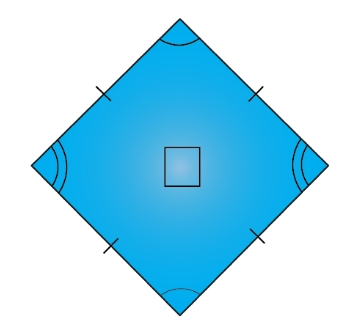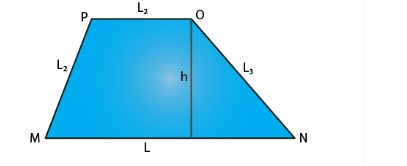
CBSE Class 6 Maths Notes Chapter 5: Students are introduced to fundamental geometric forms and figures in Chapter 5 of CBSE Class 6 Maths, Understanding Elementary forms. It discusses ideas such as lines, angles, and points and categorizes and recognizes them. students gain knowledge of the many kinds of angles (acute, obtuse, right, and straight) and lines (horizontal, vertical, parallel, and perpendicular).
In addition, the chapter covers polygons, triangles, quadrilaterals, and circles. It also teaches using a protractor to measure angles and compare shapes according to their attributes. Using straightforward, real-world examples, the goal is to provide a solid foundation in geometry and spatial awareness.CBSE Class 6 Maths Notes Chapter 5 Overview
Through the introduction of essential forms and figures encountered in everyday life, Chapter 5 of CBSE Class 6 Maths, understand Elementary forms, aids students in developing a foundational grasp of geometry. It teaches students how to recognise and categorise many kinds of angles, lines, and shapes, including triangles, quadrilaterals, and circles. In addition to introducing key ideas like parallel, perpendicular, and intersecting lines, the chapter describes how to measure angles with a protractor. Students gain analytical and spatial awareness as they study the characteristics and features of these basic shapes. In order to tackle increasingly difficult mathematical ideas in higher grades, this core understanding is necessary. It also improves their capacity to work through issues involving measurements and shapes, which makes it a crucial phase in their general mathematical education.CBSE Class 6 Maths Notes Chapter 5 PDF
Below we have provided CBSE Class 6 Maths Notes Chapter 5 Understanding Elementary Shapes pdf for the ease of the students so that they can download it and access it without internet.CBSE Class 6 Maths Notes Chapter 5 PDF
CBSE Class 6 Maths Notes Chapter 5 Understanding Elementary Shapes
Below we have provided CBSE Class 6 Maths Notes Chapter 5 Understanding Elementary Shapes - Line segment measurement, angles and their varieties, triangles and their classifications, polygons, quadrilaterals, and solid shapes are the main topics covered in this chapter. Below is a detailed explanation of each of these subjects.Measuring Line Segments
To measure line segments, one usually uses a ruler or divider. The distance between a line segment's ends can be used to determine its length.Angles and Its Types
Any two rays with the same endpoint or starting point together form an angle. The way the clock hands move helps to clarify it. A clock hand creates an angle when it moves. An angle is measured with a protractor. Remember that a right angle is 90 degrees, and a straight angle is 180 degrees. Based on the degree, an angle can be classified into 3 main types:- Acute angle: When an angle measure is less than a right angle, it is called an acute angle.
- Obtuse angle: When an angle measure more than a right angle but less than a straight angle, it is called an obtuse angle.
- Reflex angle: When an angle measure more than a straight angle, it is called a reflex angle.
Triangle and its Types
A closed figure with three sides and three internal angles is called a triangle. Triangles can be categorised according to their angles and side lengths. Below is a full classification of triangles.| Based on | Triangle Name | Description |
| Based on its sides | Scalene triangle | All three sides are unequal. |
| Isosceles triangle | Any two sides are equal. | |
| Equilateral triangle | All three sides are equal. | |
| Based on its angles | Acute angled triangle | All the angles are acute. |
| Right-angled triangle | Anyone angle is the right angle. | |
| Obtuse angled triangle | Anyone angle is obtuse. |
Polygons
Closed geometric objects with three sides and three angles at least are called polygons. A polygon can be divided into several categories according to its side count. Among the most popular polygons are:| Polygon Name | No. of Sides |
| Triangle | 3 |
| Quadrilateral | 4 |
| Pentagon | 5 |
| Hexagon | 6 |
| Heptagon | 7 |
| Octagon | 8 |
| Nonagon | 9 |
| Decagon | 10 |
Quadrilaterals
As can be seen from the above table, one kind of polygon with four sides and four angles is a quadrilateral. There are five primary forms of quadrilaterals, which are described here.| Quadrilateral Type | Property |
| Rhombus | It has 4 sides of equal length. |
| Square | It is a rhombus with 4 right angles. |
| Parallelogram | It has two pairs of parallel sides. |
| Rectangle | It is a parallelogram of 4 right angles. |
| Trapezium | It has one pair of parallel sides. |
Solid Shapes or 3D Shapes
An object that can be measured in three dimensions—length, width, and height—is referred to as a solid shape or three-dimensional shape (3D shape). 3D shapes include spheres, cubes, cuboid shapes, and cylinders. Examine three-dimensional shapes to get additional knowledge and familiarity with terminology.Measuring Line Segments
The distance between the endpoints of a line segment is called its length. Line segments can be measured by
- Comparison by observation
- Comparison by tracing
- Comparison using ruler and divider
Positioning Error
The eye must be positioned precisely, somewhat vertically above the mark, in order to obtain the right measurement. Angular viewing can lead to errors.Perpendicular Lines
Perpendicular Lines and Perpendicular Bisector
Two lines are said to be perpendicular when they intersect and the angle formed by them is a right angle. The term "perpendicular bisector" refers to a perpendicular that splits a line segment precisely at its middle.Classification of Triangles
- Triangles are those closed figures which have exactly three sides.
- Based on their sides and angles, they can be classified into different triangles.
Types of Triangles Based on Lengths of Sides
Based upon the length of the sides, triangles are classified as:- Scalene
- Isosceles
- Equilateral
Types of Triangles Based on Angles
Based upon the measure of the angles, triangles are classified as:- Acute-angled
- Obtuse-angled
- Right-angled
Quadrilaterals
A quadrilateral is a polygon which has four sides.
Comparisons between Different Quadrilaterals
Different quadrilaterals can be classified based on the lengths of the sides and angles.Rhombus
A unique kind of parallelogram with equal sides is called a rhombus. Every diagonal is perpendicular to every other diagonal. They divide the angles as well.
Trapezium
A quadrilateral with only two parallel sides is called a trapezium. There are no congruent angles, diagonals, or sides.
Polygons
A closed figure composed of two-dimensional line segments is called a polygon. Based on the quantity of sides, polygons are categorised.
Rectangle
A rectangle is a quadrilateral which has opposite sides equal and all angles are right angles. The diagonals are equal.
Square
A square is a quadrilateral which has all sides equal and all angles are right angles. The diagonals are equal and perpendicular to each other.
Three-Dimensional Shapes
Shapes that are projected onto paper but cannot be drawn on are known as three-dimensional shapes. Solids is another term for these forms.Faces, Edges and Vertices
- Each side of a three dimensional solid is called the face.
- Two faces meet at a line segment called an edge.
- Three edges meet at a point called a vertex.

Special 3D Shapes
Solids with very distinctive structures, such prisms and pyramids, are regarded as extraordinary three-dimensional forms. triangle prisms are prisms having a triangle base. A pyramid with a rectangular base is called a rectangular pyramid
A pyramid with a rectangular base is called a rectangular pyramid

Angles
Angles
Angle is the degree of rotation about the place where two planes (or lines) intersect.Right, straight and complete angles
- Right angle is equal to 90 0 .
- Straight angle is equal to 180 0 .
- Complete angle is one complete revolution or equal to 360 0 .
Acute, Obtuse and Reflex Angles
- Acute angle is lesser than 90 0 .
- Obtuse angle is greater than 90 0 .
- Reflex angle is greater than 90 0 .
Tools of Construction
- Ruler and divider are used to measure lengths of line segments.
- A protractor is used to measure angles.
Measuring Angles
- Angles are measured in degrees.
- Angles are measured by using a protractor.
Benefits of CBSE Class 6 Maths Notes Chapter 5
CBSE Class 6 Maths Notes Chapter 5 FAQs
What is the use of understanding elementary shapes?
Understanding elementary shapes is also useful for scientists and astronomers. The study of geometry starts with single points and branches out to lines and then to three dimensional objects. If you look up at the night sky you will see stars, which are single points.
What is the basic understanding of shapes?
In geometry, shapes define the outline or the boundary of an object. A shape is defined for an object or any external surface or boundary, apart from other properties such as colour or material type. For example, a blue ball, made up of rubber materials is round in shape.
Who invented elementary shapes?
Euclid
What is the purpose of learning shapes?
Letters are made up of various shapes. Learning to distinguish between shapes, therefore, helps children distinguish letters and eventually to read fluently. Besides, introducing new vocabulary words through shape-related learning helps to develop language skills.
Talk to a counsellorHave doubts? Our support team will be happy to assist you!

Free Learning Resources
PW Books
Notes (Class 10-12)
PW Study Materials
Notes (Class 6-9)
Ncert Solutions
Govt Exams
Class 6th to 12th Online Courses
Govt Job Exams Courses
UPSC Coaching
Defence Exam Coaching
Gate Exam Coaching
Other Exams
Know about Physics Wallah
Physics Wallah is an Indian edtech platform that provides accessible & comprehensive learning experiences to students from Class 6th to postgraduate level. We also provide extensive NCERT solutions, sample paper, NEET, JEE Mains, BITSAT previous year papers & more such resources to students. Physics Wallah also caters to over 3.5 million registered students and over 78 lakh+ Youtube subscribers with 4.8 rating on its app.
We Stand Out because
We provide students with intensive courses with India’s qualified & experienced faculties & mentors. PW strives to make the learning experience comprehensive and accessible for students of all sections of society. We believe in empowering every single student who couldn't dream of a good career in engineering and medical field earlier.
Our Key Focus Areas
Physics Wallah's main focus is to make the learning experience as economical as possible for all students. With our affordable courses like Lakshya, Udaan and Arjuna and many others, we have been able to provide a platform for lakhs of aspirants. From providing Chemistry, Maths, Physics formula to giving e-books of eminent authors like RD Sharma, RS Aggarwal and Lakhmir Singh, PW focuses on every single student's need for preparation.
What Makes Us Different
Physics Wallah strives to develop a comprehensive pedagogical structure for students, where they get a state-of-the-art learning experience with study material and resources. Apart from catering students preparing for JEE Mains and NEET, PW also provides study material for each state board like Uttar Pradesh, Bihar, and others
Copyright © 2025 Physicswallah Limited All rights reserved.
Get App







